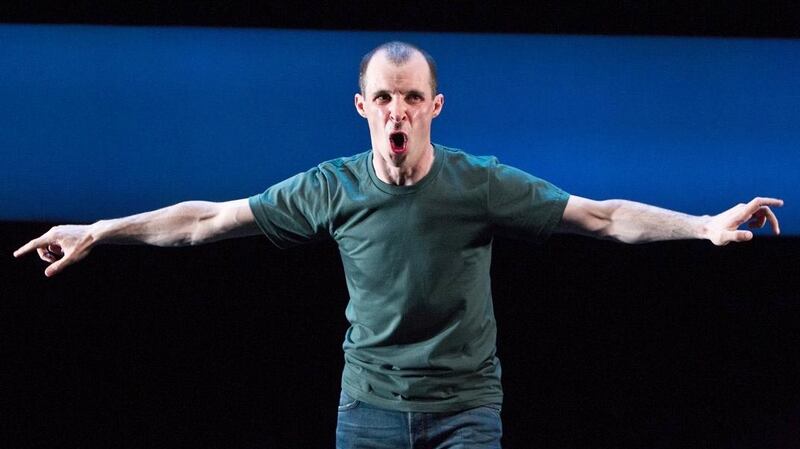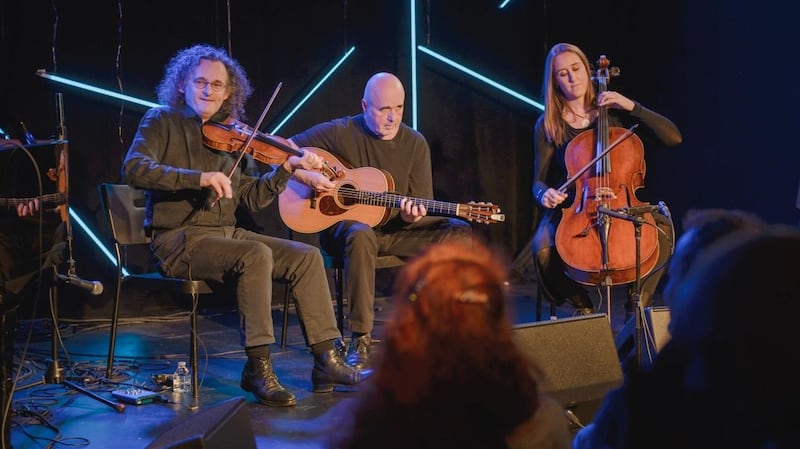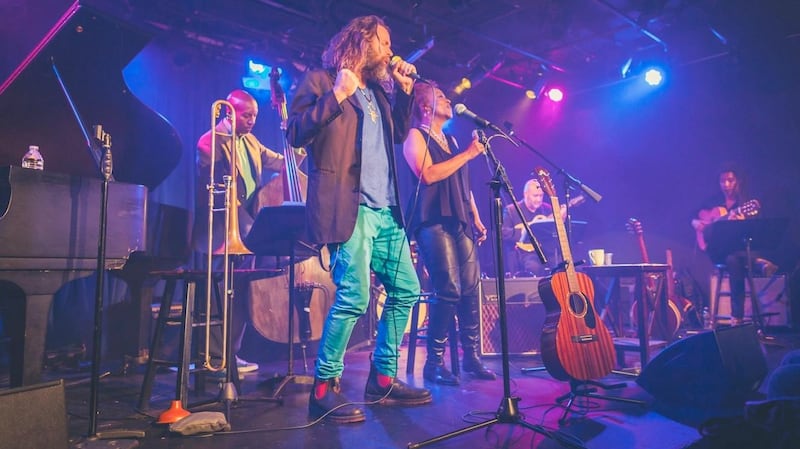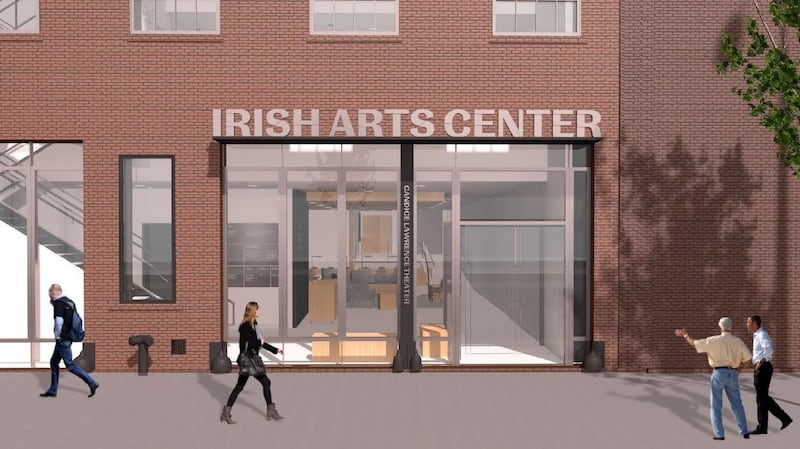In a Greek restaurant on the Upper East Side of Manhattan, a group are discussing their Irishness. DNA testing kits are big in the United States, prominently displayed in the vast pharmacies that Americans seem to either love or require. At this multi-ethnicity table, having traces of emerald green in your genome appears to be a matter of pride. Knowing about your roots makes sense in a country founded on immigration, but pausing over my pitta bread, I wonder what it is about Irishness that exerts such a romantic pull.
One reason is the strong attraction to the narrative of having risen, defiant over centuries of oppression, and of a country that wasn’t part of the colonial projects that ravaged continents – although Irish people certainly participated in numbers. In some communities, Ireland’s over-arching English-speaking whiteness helps, but behind it all is the country’s extraordinarily strong tradition of generous hospitality, and exceptional cultural reputation.
That evening, at the Irish Arts Center (IAC), housed in a tiny tenement building in Hell's Kitchen, jazz musician Cassandra Wilson takes the stage. She performs a breathtaking version of Ntozake Shange's poem, People of Watts, to a gentle guitar accompaniment, then tells the crowd how she is 12 per cent Irish, again with an accompanying aura of pride.

Wilson is appearing as part of Muldoon's Picnic, an occasional series of eclectic gatherings, hosted by Paul Muldoon the Pulitzer Prize-winning Irish poet, who has lived in the US since 1987. During the course of the evening, the crowd will enjoy comedy, poetry and music. Singing torch songs is Puddles the Clown (aka Mike Geier), whose exquisite pathos is undermined by the fact that he's more than two metres tall, and dressed as a pierrot.
If I had imagined the IAC to be a spot for lonely emigrants, yearning for a little fadó fadó, and a chance to slap bodhráns together, I was wrong. Yes, they hold Irish dancing, tin whistle, and language classes; but the 99-seater theatre programmes a mix of music, spoken word, film and drama, and audiences come from a wide range of ethnic and cultural backgrounds and affiliations.
Sonya Kelly's How to Keep an Alien played here, as did Deirdre Kinahan's These Halcyon Days, and Mikel Murfi's I Hear You and Rejoice. Off-site projects include bringing This Is Pop Baby's Riot to the Skirball at NYU, a 900-seater theatre. How much of a risk was it, bringing a show that involves a former GAA star, Ronan Brady, semi-naked, spraying the audience with Tayto while performing aerial dance, to audiences once more-used to the Irishness of The Quiet Man? "The Irish Arts Center has been working hard to update the face of Irish Arts," says Philly McMahon of This Is Pop Baby . "Once a great New York Times review dropped, the audiences were everybody and anybody."

The IAC also hosts collaborative residencies, such as one which paired Liam ó Maonlaí with Cassandra Wilson, and culminated in a tour taking the duo to venues in Los Angeles and Chicago. Those connections are what attracts fiddle player Martin Hayes. "If this was a social club, I would never have got involved. I was quite sceptical in the first place," says Hayes. "For Irish artists to succeed in America, they have to reach outside the diaspora and have a relevance beyond. You don't want to ignore that audience, but you don't want to be ghettoised. When I was putting The Gloaming together," he adds, "I said to Iarla [ó Lionáird] and Thomas [Bartlett] 'let's meet at the IAC, there's a piano over there…'. It's still my hub for facilitating collaborations, I enjoy it a lot."
The strategy clearly works. The IAC have successfully raised over $60million, and broken ground on a new venue, which will include a theatre, as well as a library, studios and bar/cafe area. The original building will also be renovated, and included in the new centre. All of this raises the question of what an Irish arts centre, anywhere in the world, might actually be for, and why it might matter in today’s hyper-connected world. The idea of a community space for first-generation arrivals, lonely off the boat is, today, as archaic as the idea of arriving by boat at all.
When Brian Heron established the IAC, back in 1972, in its original base on the Lower East Side, he described his purpose to the New York Times as being a cultural educator. "There are very few real Irish people in the United States," he said. "They know little about authentic Irish culture, and care less […]We have to go back to the beginning, to learn again what it means to be Irish." Gore Vidal, Arlo Guthrie and Liam Clancy were named on the first board of advisers.

A grandson of James Connolly, Heron, who died in 2011, had a background in the trade-ynion movement, and had founded the National Association for Irish Justice, which organised Bernadette Devlin's US fundraising tour in 1969. If re-education was going on, it had a definite slant. The Irish Rebel Theater was the in-house company.
That older cultural purpose has shifted. After Heron came Jim Sheridan. Now, Aidan Connolly, the IAC's current executive director, describes how "the notion of a homogenous Irish America doesn't exist, or not so much that it's an organising principle. Instead, we are positioning what we do to the voracious New York cultural consumer, but all the time bathing the whole mentality in Irish hospitality, which creates community."
Irish theatre has a way of being able to throw your emotions from heartbreak, to fear, to hilarity in one place
Looked at through that lens, is it possible to describe such a thing as Irish culture? A particularly Irish sensibility? In 1971, New York-based Irish artist and writer Brian O’Doherty described Irish art’s “atmospheric mode” and “restless fix on the unimportant,” but a great deal has changed in the decades since. The IAC’s visual arts programming has always been its weakest link, though Connolly suggests the greater space in the new building will lead to greater ambition.
In literature, music and theatre, however, the punching-above-its-own-weight influence of Irish culture is thanks to a network of connections, some deliberate, some pure serendipity. Susan Feldman, founder and artistic director of St Anne's Warehouse, has been seeking out Irish productions for the past decade. After we speak, she is due to fly to Dublin, to catch Landmark and The Everyman's production of Louise O'Neill's Asking for It. Enda Walsh's adaptation of Max Porter's Grief is the Thing with Feathers will play at St Ann's in April 2019.

What brings an acclaimed New York artistic director thousands of miles to Ireland to check out new drama? Feldman's first Irish connections came even further from home, when she met the director of the Galway International Arts Festival , Paul Fahy, at the Adelaide Festival in South Australia, and hit it off immediately. Irish theatre, says Feldman, "has a way of being able to throw your emotions from heartbreak, to fear, to hilarity in one place."
Another key ambassador has been the Druid theatre's Garry Hynes, who was the first woman to win a Tony Award for direction, for Martin McMcDonagh's The Beauty Queen of Leenane in 1998. "I have never seen such wild story telling," says Feldman of McDonagh's work. "It freaked me out."
Audiences love the fact that they don't get all the references, but know they are part of something authentic
"Historically, New York has always had a sweet spot for the Irish community," says Karen Brooks Hopkins. A former president of BAM, Brooks Hopkins is now senior advisor at the Onassis Foundation. She describes the IAC as a "melting pot, very publicly oriented, rather than being there to serve a single ethnic community". "Certain cultures," she continues, "lend themselves to a very powerful artistic output." She speaks of the "Irish point of view" and "an Irish sensibility," so I ask her what she thinks that might look like. "In theatrical terms, it's very family-oriented," she says. "But it's often a very dysfunctional family," she laughs. "But it runs deep, and it's not something that can be cast off lightly."
"People sometimes ask us how work that seems so specific to Ireland connects with audiences in New York," says Fishamble's Jim Culleton, who has worked with the IAC on numerous occasions and is planning a co-production for the first season in the center's new home. "In fact, audiences love the fact that they don't get all the references, but know they are part of something authentic."

Support is also practical. Connolly estimates that between $30,000 and $40,000 per year is spent on facilitating visas for Irish artists. They also bring critics in to see the shows. "It was because of my work in the IAC, and being a Critic's Pick in the New York Times that I won an agent there," says playwright Deirdre Kinahan, who is also quick to acknowledge Culture Ireland's role in the mix.
Camille O’Sullivan, another IAC resident, echoes the strong affection that emanates from those who work with the center. “Artists live quite a nomadic gypsy life,” she says. “And there are certain loving motherships that exist in the world. You go there and they put their arms around you. It’s my most terrifying and favourite venue of all time, because it’s so intimate.”
With the new building due to open in 2020, fundraising continues, led by Connolly and Pauline Turley, vice-chair of the center, with philanthropist Loretta Brennan Glucksman and her campaign co-chair Robert Devlin. The ask is getting harder, says Glucksman, a previous chair of the American Ireland Fund. Liam Lynch, publisher of Irish Central agrees. "What's the big reason to care about Ireland just now? That's the question for Irish America, for the diaspora, for Irish philanthropy." If the downside is not having such plausible reasons to plead poverty, the upside is a thriving and growing reputation around the world. "It's a privilege to have seen the metamorphosis," says Glucksman. "In the past Irish people knew their own value, but they had been told they didn't have it."
While I'm in New York, Druid's Waiting for Godot has sold out at the Lincoln Center, as has Conor McPherson's The Girl from the North Country, one of the hottest tickets in town, at The Public Theater. McPherson's play weaves Bob Dylan songs throughout its Minnesota Depression-era narrative, and the audience in the packed theatre is spellbound. There's nothing particularly Irish about it, and yet I'm reminded of something Karen Hopkins said about Irish drama, and our shared humanity: how it "shows how we're all different, and yet the same. That's what art does."
irishartscenter.org











